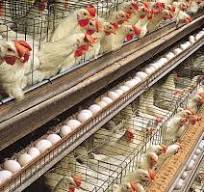The livestock sub-sector is an important component of the Nigerian Agricultural Economy. its importance derives from the fact that it is one at the key contributors to the national economy. For example. Using the 1984 factor based data, the sub-sector contributed on an annual basis, a little over 5% of the Gross Domestic Product (GDP) between 1996 and year 2000. According to CBN, the livestock sub-sector is second only to the crop sub-sector under the sub-sector contribution to the general agricultural sector. And represents an average over 13% of agriculture's contribution during the period under consideration.
In terms of specific output. The livestock sub-sector can be broken into product sub-groups such as. Poultry meat, goat meat, lamb/mutton, beef, pork, milk and eggs.
However, it is noteworthy that the livestock sector has not provided sufficient volumes and the capacity to meet the demand of over 150 million Nigerians for protein.
The annual growth rate has been low for most of the products. Particularly for poultry and eggs subgroup. Whereas, the subgroup, if properly managed. Could impact greatly on the income and quality at life of the citizenry. This is because poultry production is a social-economic activity that has high rating for the reason that the net return on investment is relatively higher than that of other animal species and its contributing role to national economy cannot be overemphasized.
Thus it is the major source at high quality protein that is necessary for the continued survival of the fastest growing human population of a developing economy.
Poultry meat and eggs offer considerable potential for meeting human needs for dietary animal supply & Egg production involves the use of good layer birds for Materials and Methods the purpose of table egg production. The eggs are sold off fresh to the public while the layers, which are no longer laying egg well, are culled of from the farm.
This project involves starting a small scale poultry farm in any big city of Nigeria which will produce premium egg and layers to be sold in the local market, competing with existing farms. The farm will be equipped with modern facility for all the processes in order to ensure the quality of the final products.
The SWOT analysis showed that the opportunities of the business outweigh the challenges and was concluded that poultry farming idea is healthy and feasible in Nigeria.
In terms of specific output. The livestock sub-sector can be broken into product sub-groups such as. Poultry meat, goat meat, lamb/mutton, beef, pork, milk and eggs.
However, it is noteworthy that the livestock sector has not provided sufficient volumes and the capacity to meet the demand of over 150 million Nigerians for protein.
The annual growth rate has been low for most of the products. Particularly for poultry and eggs subgroup. Whereas, the subgroup, if properly managed. Could impact greatly on the income and quality at life of the citizenry. This is because poultry production is a social-economic activity that has high rating for the reason that the net return on investment is relatively higher than that of other animal species and its contributing role to national economy cannot be overemphasized.
Thus it is the major source at high quality protein that is necessary for the continued survival of the fastest growing human population of a developing economy.
Poultry meat and eggs offer considerable potential for meeting human needs for dietary animal supply & Egg production involves the use of good layer birds for Materials and Methods the purpose of table egg production. The eggs are sold off fresh to the public while the layers, which are no longer laying egg well, are culled of from the farm.
This project involves starting a small scale poultry farm in any big city of Nigeria which will produce premium egg and layers to be sold in the local market, competing with existing farms. The farm will be equipped with modern facility for all the processes in order to ensure the quality of the final products.
The SWOT analysis showed that the opportunities of the business outweigh the challenges and was concluded that poultry farming idea is healthy and feasible in Nigeria.
Executive Summary
Introduction
Business Overview
3.1 Business Description
3.2 Mission Statement
3.3 Vision Statement
3.4 Goals and Objectives
Market Analysis
4.1 Industry Overview
4.2 Market Trends
4.3 Target Market
4.4 Competitor Analysis
Legal and Regulatory Considerations
5.1 Business Registration
5.2 Permits and Licenses
5.3 Compliance with Health and Safety Regulations
Operational Plan
6.1 Location and Facilities
6.2 Production Process
6.3 Quality Control Measures
6.4 Supply Chain Management
Marketing Strategy
7.1 Product Offering
7.2 Pricing Strategy
7.3 Promotion and Advertising
7.4 Distribution Channels
Financial Plan
8.1 Start-up Costs
8.2 Revenue Projections
8.3 Expenses Forecast
8.4 Financing Options
8.5 Break-even Analysis
Risk Management
9.1 Identification of Risks
9.2 Risk Mitigation Strategies
Human Resources
10.1 Organizational Structure
10.2 Staffing Requirements
10.3 Training and Development
Environmental Sustainability
11.1 Waste Management
11.2 Energy Efficiency
Conclusion
Appendices
13.1 Business Plan Assumptions
13.2 Financial Projections
13.3 Supporting Documents
Introduction
Business Overview
3.1 Business Description
3.2 Mission Statement
3.3 Vision Statement
3.4 Goals and Objectives
Market Analysis
4.1 Industry Overview
4.2 Market Trends
4.3 Target Market
4.4 Competitor Analysis
Legal and Regulatory Considerations
5.1 Business Registration
5.2 Permits and Licenses
5.3 Compliance with Health and Safety Regulations
Operational Plan
6.1 Location and Facilities
6.2 Production Process
6.3 Quality Control Measures
6.4 Supply Chain Management
Marketing Strategy
7.1 Product Offering
7.2 Pricing Strategy
7.3 Promotion and Advertising
7.4 Distribution Channels
Financial Plan
8.1 Start-up Costs
8.2 Revenue Projections
8.3 Expenses Forecast
8.4 Financing Options
8.5 Break-even Analysis
Risk Management
9.1 Identification of Risks
9.2 Risk Mitigation Strategies
Human Resources
10.1 Organizational Structure
10.2 Staffing Requirements
10.3 Training and Development
Environmental Sustainability
11.1 Waste Management
11.2 Energy Efficiency
Conclusion
Appendices
13.1 Business Plan Assumptions
13.2 Financial Projections
13.3 Supporting Documents
$100 (N150,00)
reach us for Trade Finance Offer : admin@fundxperts.com
Contact us : admin@fundxperts.com

